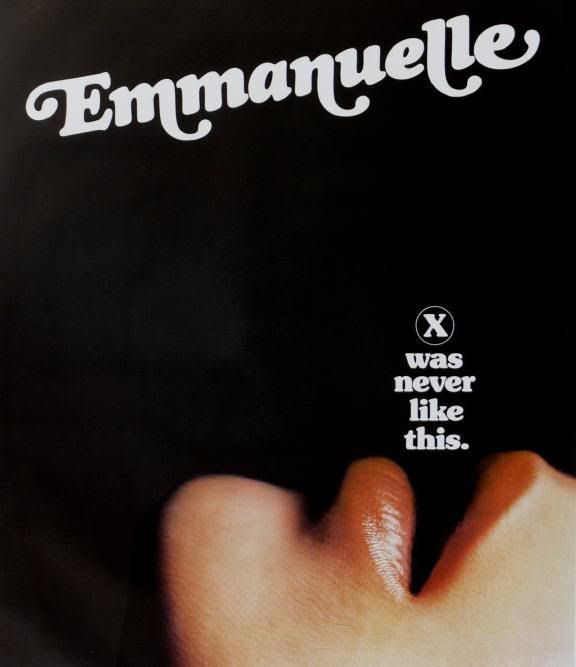

"Emmanuelle" was first adapted to screen in 1969 as "Io, Emmanuelle," or alternately "A Man for Emmanuelle," and bore little resemblance to the book. The lead was played by Erika Blanc, who went on to become a scream queen, but this Italian production did poor box office.
In the early 70's, Yves Rousset-Rouard optioned the film rights for "Emmanuelle" to serve as his first feature. From the start, Rousset-Rouard saw "Emmanuelle" as a commercial vehicle, but one of quality, and looked to make the most from what little he had to spend. Rousset-Rouard bypassed film veterans, mostly in favor of people with a background in advertising. An exception was Jean-Louis Richard, who adapted the book, and had co-written the screenplays to François Truffaut's "The Soft Skin," "The Bride Wore Black," "Day For Night" and "Fahrenheit 451." The other was Claudine Bouché, a film editor for Truffaut.
The producers could not find many actresses with an interest in the part. Fashion photographer-turned-director Just Jaeckin has said, "We were looking for an Asian girl, with dark hair. And I saw this beanpole with short hair. It was Sylvia Kristel... I called Yves, who said, 'You're mad, she isn't the character at all!'" Screenwriter Jean-Louis Richard disagreed, and the producers eventually came around to her "ingenuity, and her purity."
Producer Yves Rousset-Rouard wanted to replicate the impact and legitimacy of "Last Tango in Paris," and so pursued the respected actor Alain Cuny, best known as "Steiner" from Federico Fellini's "La Dolce Vita." Cuny proved to be a scornful terror on the set, as well as in dubbing.
Emmanuelle and Jean's rental home in the movie was a palace provided by Prince Panooh Pan. The cousin of the king also helped the production bypass heavy moral restrictions that would have otherwise prevented any filming in Thailand.
Viewers may wonder why there was no sex scene during the waterfall sequence with Emmanuelle and Bee. This was because the Buddhist monks crossing a bridge in one scene called the police and had the crew arrested for cavorting in sacred waters. This had an adverse effect on location access for the rest of the shoot, requiring many scenes intended for Thailand to be shot in Paris. These included the squash sequences, the opium den, and the swimming pool.
During Emmanuelle and Bee's courtship, there's a beautiful sequence where the pair ride horses during sunrise. Despite assurances to the contrary, Sylvia Kristel admitted on the day of shooting that she could not ride a horse. Cinematographer Richard Suzuki ended up substituting for Kristel in all those shots.
Editor Claudine Bouché and screenwriter Jean-Louis Richard were the saviors of the film, making scenes that seemed impossible work, and going so far as to perform their own reshoots of key scenes. It was Bouché who turned the non-ending of the film (such as it is) around, removing reams of Mario's "terribly pompous" pseudo-philosophy. She instead focused on Emmanuelle alone in the mirror, "which makes you think that maybe it was just a dream. It gave another dimension to the movie, which I find more interesting than all the rest of it... It was an ordinary, not very good film. But it's true that it was different from everything we had seen..."
Knowing producer Yves Rousset-Rouard had little money to go around, screenwriter Jean-Louis Richard, director Just Jaeckin and star Sylvia Kristel all accepted shares in the film's profits instead of much front money. Nurturing a cocaine habit, Kristel sold her share to her agent for $150,000, which ended up being worth millions. Nearly everyone involved with the film, including technicians, were offered profit sharing in lieu of paychecks, but refused.
The film's trailer was slyly provocative with an insider quality, and highly effective. Lines include, "Emmanuelle. It was a book. It became a film. Emmanuelle. If this title reminds you of nothing... ask your friends. They'll explain it to you. Emmanuelle: the longest caress of French cinema." The film played in a Champs-Élysées theater for, depending on the source, between eleven and thirteen years. Huge in France, the film's fortunes continued to Japan, where its star became a cult figure. The United States screened an edited version, but performed well with the tagline, "X was never like this." Riots broke out in Buenos Aires in the rush to see the picture. Audiences left Spain, where the film was banned, to see it in France.


No comments:
Post a Comment